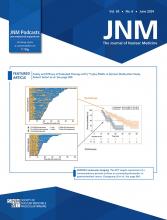A 34-y-old woman with metastatic estrogen receptor (ER)–positive invasive ductal carcinoma of the left breast and biopsy-proven ER-positive sternal metastasis underwent mastectomy, chemotherapy, and radiation to the chest wall and sternum. [18F]fluoroestradiol (FES) PET/CT 1 mo after radiation (Fig. 1A) demonstrated no abnormal uptake. [18F]FES PET/CT 5 mo after radiation (Fig. 1B), after initiation of the ER-blocking agent tamoxifen, demonstrated new avid opacities anteriorly in the left lung (SUVmax, 7.7), as well as avidity in the hilar nodes (SUVmax, 5.6) and superior mediastinal node (SUVmax, 4.5), findings that were favored to represent the acute postradiation changes that can be seen 1–6 mo after completion of radiation (1). [18F]FDG PET/CT 6.5 mo after radiation (Fig. 1C) demonstrated nearly complete resolution of the lung opacities and no abnormal lung or nodal uptake, consistent with resolving postradiation changes. Acute postradiation lung changes can progress to chronic fibrosis starting around 9 mo after radiation or can resolve, as in our patient (1). At 17 mo after radiation, the patient continued to have no evidence of disease.
(A) [18F]FES PET/CT (coronal PET maximum-intensity projection [MIP], sagittal fused PET/CT, axial fused PET/CT, and axial CT) 1 mo after radiation, showing no abnormal findings and physiologic uterine uptake (arrow). (B) [18F]FES PET/CT (coronal PET MIP, sagittal fused PET/CT, axial fused PET/CT, and axial CT) 5 mo after radiation and after tamoxifen, showing new avid left lung opacities (black arrows), avid hilar nodes (solid white arrows), and avid superior mediastinal node (dashed white arrow), findings favored to represent acute postradiation changes. Because of ER blockade, no uterine uptake was seen (dotted-dashed white arrow). (C) [18F]FDG PET/CT (coronal PET MIP, axial fused PET/CT, and axial CT) 6.5 mo after radiation, showing nearly resolved lung opacities (arrows) and no abnormal uptake, consistent with resolving postradiation changes. RT = radiation.
Per appropriate use criteria, [18F]FES is rarely appropriate for measuring response to therapy (2), and ER-blocking drugs interfere with [18F]FES binding to tumor ER (3). This case, however, elucidates an [18F]FES false-positive finding after successful ER blockade evidenced by elimination of physiologic uterine [18F]FES avidity (Figs. 1A and 1B).
A retrospective study reported [18F]FES-avid postradiation pulmonary changes without a clear mechanism and without [18F]FES-avid regional nodes (4). Although the lungs have low-level ER (5) that may play a part in [18F]FES uptake in atelectasis, increased uptake despite ER blockade suggests that [18F]FES-avid postradiation lung changes are not due to ER binding and that associated [18F]FES-avid regional nodes may be due to physiologic drainage of [18F]FES from the lungs. This case provides some insight into the nature of false-positive changes on [18F]FES PET/CT after pulmonary radiation and demonstrates the associated finding of [18F]FES-positive draining nodes.
DISCLOSURE
Sophia O’Brien, Austin Pantel, and David Mankoff are consultants for GE Healthcare. No other potential conflict of interest relevant to this article was reported.
Footnotes
Published online Jan. 18, 2024.
- © 2024 by the Society of Nuclear Medicine and Molecular Imaging.
- Received for publication August 10, 2023.
- Revision received December 19, 2023.








